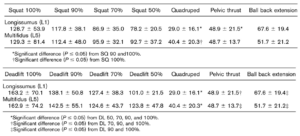ABS & UPPER-LOWER BODY EXERCISES
Click on Image to Enlarge
UPPER BODY EMG STUDIES
RECTUS ABDOMINIS, EXTERNAL OBLIQUE, ERECTOR SPINAE
– DB Overhead Press
Muscle activity of the core during bilateral, unilateral, seated and standing resistance exercise – Saeterbakken – 2011
Procedure
– 15 healthy males performed five repetitions of DB Overhead Press at 80% of 1RM
Results
Rectus Abdominis: stand bilateral 90 . stand unilateral 80 . seated unilateral 35 . seated bilateral 20
External Oblique: stand bilateral 40 . stand unilateral 15 . seated unilateral 15 . seated bilateral 30
Erector Spinae: stand bilateral 5 . stand unilateral 10 . seated unilateral 10 . seated bilateral 5
RECTUS ABDOMINIS, EXTERNAL OBLIQUE, ERECTOR SPINAE, MULTIFIDUS
– DB Row, Seated Unilateral Cable Row, Machine Unilateral Row
The effect of bilateral and unilateral row exercises on core muscle activation · 2015 – Saeterbakken; Vidar Andersen Procedure
Procedure
– 15 resistance-trained men
Results
External oblique: db row 25% · seated cable unilateral 15% · machine unilateral 15%
Rectus abdominis: no significant differences
Erector spinae: bb row 30% · db row 28% · seated cable bilateral 25% · machine bilateral 25%
· seated cable unilateral 15% · machine unilateral 12%
Multifidus: bb row 22% · db row 22% · machine bilateral 20% · seated cable bilateral 18%
· seated cable unilateral 15% · machine unilateral 15%
LOWER BODY EMG STUDIES
RECTUS ABDOMINIS, EXTERNAL OBLIQUE, ERECTOR SPINAE
– Squats, Leg Press, Smith Machine
Core Muscle Activation in Three Lower Extremity Exercises With Different Stability Requirements – Saeterbakken – 2022
Procedure
– compare core muscle surface electromyography (sEMG) during 3RM and the sEMG amplitude in the turnover from the descending to ascending phase
Results
Erector Spinae: squats 75 . smith machine 75 . leg press 65
Rectus Abdominis: squats 17 . smith machine 15 . leg press 10
External Oblique: squats 20 . smith machine 17 . leg press 14
RECTUS ABDOMINIS, EXTERNAL OBLIQUE, LONGISSIMUS, MULTIFIDUS
– Multiple Exercises
 Trunk Muscle Activity During Stability Ball and Free Weight Exercises – Nuzzo, McBride – 2008
Trunk Muscle Activity During Stability Ball and Free Weight Exercises – Nuzzo, McBride – 2008
Procedure
– compare trunk muscle activity during stability ball and free weight exercises
– 9 resistance-trained men; squats (SQ) and deadlifts (DL) were completed with loads of approximately 50, 70, 90, 100%1RM
Exercises
1. Quadruped – Big Ball: Bird Dog
2. Pelvic Thrust – Big Ball: shoulders & head on floor; feet on ball; legs straight through movement; not a hip thrust
3. Back Extension – Big Ball: both feet remained in contact with the floor; hands were placed behind the head throughout the movement.
4. Squat: repetitions were complete when a 70° knee angle was attained
5. Deadlift: feet were shoulder-width apart; grip lateral to the legs with an alternating grip
Results – Deadlift & Squat @70%RM
Rectus Abdominus (RA): no significant differences observed
External Oblique (EO): no significant differences observed
+ Longissimus(L1): Deadlift 130 . Squat 90 . Ball Back Extension 70 . Pelvic Thrust 50 . Quadruped 30
+ Multifidus (L5): Deadlift 125 . Squat 95 . Ball Back Extension 50 . Pelvic Thrust 50 . Quadruped 40